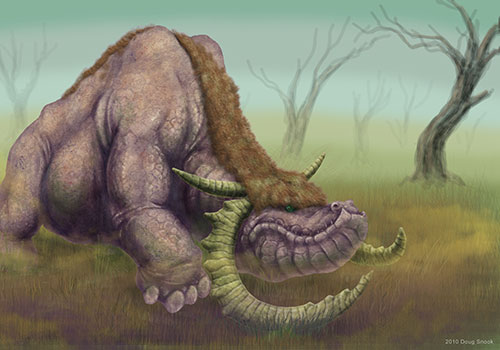Terra Advena - Domesticated Beasts, part 2

Last time, we talked about the common domesticated animals in Advena, creatures you might expect to see but won't, and those specific to gnolls. Today we're going to cover a few more.
Birds, Worms, Snails, and Lizards
While gnolls may only have adopted the wild boar, in addition to the donts and chicken that most of the races cultivate, the kenku have an entire stable of creatures that they make use of in everyday life. They are most known for their giant lizards, a part of the monitor family (much like modern komodo dragons). Slow and stupid, the creatures - simply called 'lizards' by most - are heavy and low-slung, and weigh upwards of four hundred pounds. With a reputation for general ill-temper, one might think that the kenku they so greatly outweigh would find them intimidating, but the birds keep them in hand with switch and aggressive training. It helps, to be sure, that the lizards subsist primarily on grains and fruit, though during times of heavy labor the kenku supplement their diets with fish.
In addition to the distinctive lizards, kenku have also 'domesticated' the silk worm - and they consider their methods amongst their most valuable of secrets, because the silk they obtain from them is the primary economic export for the kenku. Each kenku flock includes several wagons specifically built to provide nesting for the silkworms, and most flocks also use the rafters of their residential wagons to hold small amounts of reserve silkworms. When threatened by brigands or beasts, kenku flock protect their silk wagons above all else.
Finally, the kenku have also formed a symbiotic relationship with a breed of fast-growing snail. Each kenku wagon contains a sort of shelf that hangs below the wagon proper, providing space for a small dirt-, moss-, and mushroom-laden bed that nurtures scores of snails. The kenku, in turn, regularly harvest snails and mushrooms from the beds for food.
Smarter Lizards and the Ugliest Cows Ever
Sharing somewhat with the kenku, the dragonborn of eastern Advena also make use of the lizards as a common draft animal - a fact that the gnolls have spent centuries chuckling at, considering the apparent similarities (that is, scales) between the dragonborn and the pack lizards. The dragonborn, however, feel no such kinship to the beasts, and the lizards are a common site through Bein-Zoltak, on the roads and even within cities, where the creatures lounge in alleys waiting for scraps and being put to work as needed.
In addition to the pack lizards, the dragonborn make use of the dangerous catoblepas for heavier work. The catoblepas appears something like an oversized rhinocerous - the creature can reach up to fifteen feet in height, and significantly longer in length - but with a broad humped back and an elongated neck, similar in proportion to the body of that of a giraffe. Unlike the giraffe, however, the catoblepas's head is enormous, and the neck is unable to support it well, thus making the creature keep its head lowered to the ground almost constantly. In addition, both male and females sport curving horns of bone that jutt from both sides of their head and can reach up to three or four feet in length. Despite all this, the most dangerous feature of the catoblepas is their gaze, which mystically slows, then stuns, and eventually petrifies living creatures that meet it for too long a time. Thankfully, given their weak neck, the catoblepas rarely looks other creatures in the eye.
Dwarves and Goats
The dwarves of Advena make extensive use of the common chicken, but the larger glyptodonts are ill-suited for mountain living. Instead, the stocky humanoids have domesticated the mountain goat, which serves a similar role, providing both wool and milk for its masters. Traditionally, dwarves allow the goats somewhat free range outside of their mountain cities, with a small number of herders - dwarves who have displeased someone - watching over them. This led to early conflicts with humans, when the latter assumed the goats roaming freely were wild and up for the taking. Word to the wise - don't steal a dwarf's goat.